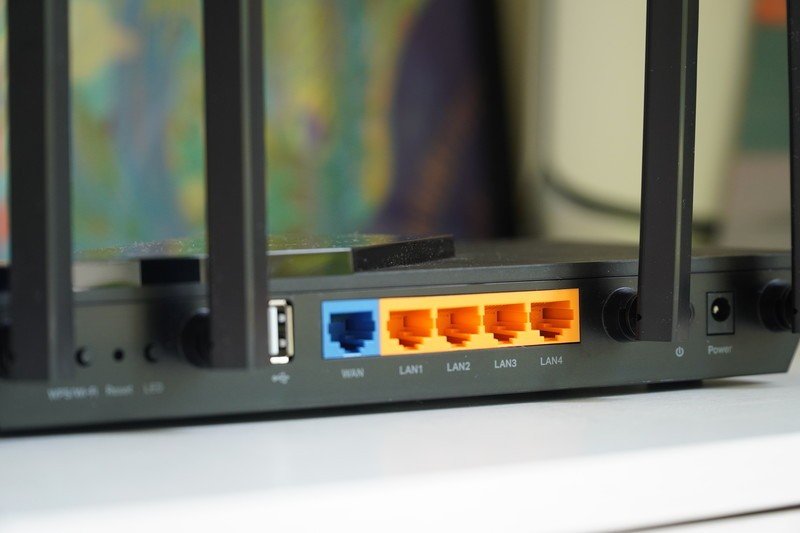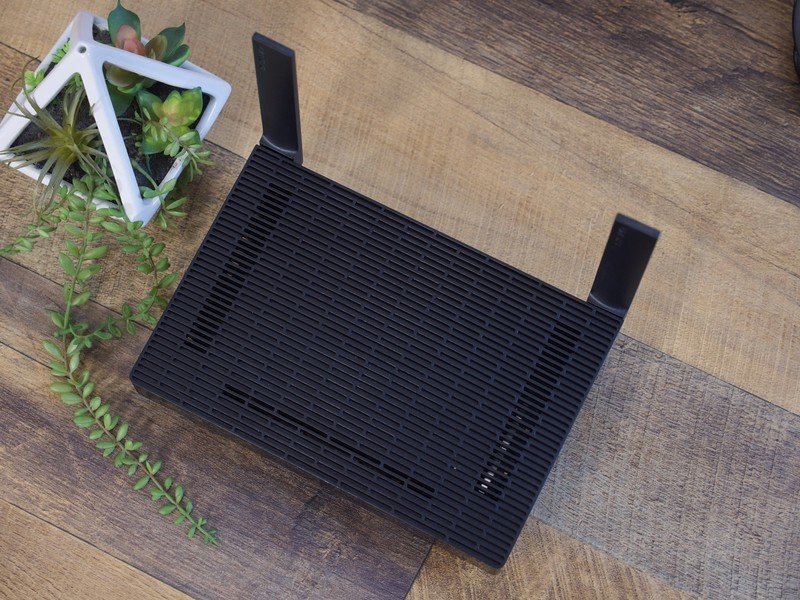Android Central Verdict
Bottom line: The TP-Link Archer AX21 is one of the best cheap Wi-Fi 6 routers thanks to its solid AX1800 speeds, with good coverage for an average three-bedroom home. The AX21 is also compact at just a bit over 10 inches wide and six inches deep.
Pros
- +
AX1800 speeds are plenty for most homes
- +
Compact housing
- +
Better coverage than expected
- +
Plenty of options to customize your network
Cons
- -
Not enough capacity for a large family
- -
2.4GHz speeds could be a weak point
- -
Parental controls are lacking compared to other TP-Link options
Why you can trust Android Central
The TP-Link Archer AX21 is one of the cheapest Wi-FI 6 routers TP-Link makes, but most of the people that use it would never know. The Archer AX21 has all of the most important features you want in a WI-FI 6 router, such as solid AX1800 speeds, basic parental controls, and quality of service controls. As long as you don't have too many devices or expect to cover a big house, the Archer AX21 will have no trouble keeping up with even gigabit connections, though Wi-Fi 5 performance will be a bit lackluster.
The Archer AX21 is a compact router at just under six inches deep, including the antennas. Not everyone wants to see their wireless router, so it's nice that you can tuck your Archer AX21 out of sight relatively easily. The router still includes four gigabit ethernet ports for LAN and a USB port. You can also use this router as the base for a mesh with OneMesh supported extenders.
TP-Link Archer AX21: Price and availability

The TP-Link Archer AX21 is available in most places TP-Link routers can be purchased, including Amazon. Normally priced at $100, it can often be found on sale for $90. This is one of the cheapest Wi-Fi 6 routers around, and it replaced TP-Link's Archer AX1800 with a nicer design and OneMesh support. It was first available in the second half of 2020 and has since received several firmware updates, including one that added scheduling to parental controls.
TP-Link Archer AX21: What works well

The TP-Link Archer AX21 has a fairly common AX1800 wireless connection. This breaks down to 574Mbps at 2.4GHz and 1201Mbps at 5GHz. With only four streams, the maximum connection speed you will get on any single device is 1201Mbps with Wi-Fi 6. Wi-Fi 5 devices will be limited to 867Mbps. For the most part, 2.4GHz devices won't utilize the entire connection's speed, but if you have a smart home with multiple cameras, you may start to see the limits of that connection.
For most people, dual-band speeds are more than enough, especially with Wi-Fi 6.
On the back of the router, you have four antennas with full articulation, four Ethernet ports, and a USB port. The Ethernet ports are nothing special at gigabit speed but should get the job done. The USB port is nice to have, but at 2.0 speeds, it's not a good option for connected storage beyond photos and basic documents.
The Archer AX21 is a dual-band router meaning it can use both the 5GHz and 2.4GHz bands at once. Some routers are tri-band like the TP-Link Archer AX90 and can utilize another 5GHz band to add much greater capacity. This all just means that if you're trying to download large files on multiple devices, the Archer AX21 will start to lose some speed. Dual-band speeds are more than enough for most people, especially with Wi-Fi 6.

You can enable Smart Connect when you set up your Wi-Fi to allow your router to assign your devices to the different bands automatically. This is nice because you won't need to connect to a separate Wi-Fi name.
I ran a few speed tests around my home to see how well the AX21 was able to keep up with my 500Mbps internet connection. My connection is from Cox and I pay for 500Mbps down with 10Mbps up. The upload speeds on Cox are so slow they're not worth testing, as this router will have no trouble keeping up at any testing point.
The router was allowed to automatically configure its channels and channel widths as this is how most people would be using it. You could theoretically improve 2.4GHz performance with a 40MHz channel, but it would be more susceptible to interference.
2.4GHz (20MHz) results (two tests):
| Location | Living room (router) | Front room | Bathroom |
|---|---|---|---|
| Galaxy S20+ | 98.9 Mbps116 Mbps | 79.5 Mbps87 Mbps | 66.7 Mbps98.9 Mbps |
| LG G8 (Wi-Fi 5) | 90.2 Mbps92.8 Mbps | 89.7 Mbps50.1 Mbps | 88.4 Mbps66.4 Mbps |
| iPhone 11 Pro | 89.6 Mbps97.3 Mbps | 100 Mbps92.3 Mbps | 68.5 Mbps66 Mbps |
The router chose a higher 5.8GHz channel for this connection, which is probably the best bet. There's far less traffic on this higher channel in my area, leading to some pretty solid speed test results. You can change the channel width and channel in the advanced options with a web browser.
5GHz (80MHz @5.8GHz) results (two tests):
| Location | Living room (router) | Front room | Bathroom |
|---|---|---|---|
| Galaxy S20+ | 543 Mbps516 Mbps | 427 Mbps436 Mbps | 430 Mbps361 Mbps |
| LG G8 (Wi-Fi 5) | 446 Mbps470 Mbps | 313 Mbps257 Mbps | 247 Mbps225 Mbps |
| iPhone 11 Pro | 522 Mbps568 Mbps | 385 Mbps430 Mbps | 348 Mbps348 Mbps |

Another nice feature is OneMesh. OneMesh can use compatible TP-Link network extenders to improve your coverage without having to change which access point you're connected to. OneMesh will automatically switch your device to the node that makes the most sense. Your speeds will be cut roughly in half when connected to a remote node, but the connection will be more consistent than trying to connect to the main router.
TP-Link Archer AX21: What's not so good

While many people will have plenty of speed with the Archer AX21, there's no getting around the fact that it is one of the slowest Wi-Fi 6 routers you can get. It also doesn't support 160MHz connections. While far from a dealbreaker for most people, if you have a 160MHz Wi-Fi adapter, you won't be able to use it to the fullest. Devices will only ever connect at 1201Mbps on Wi-Fi 6 compared to the 2402Mbps on some other routers. Wi-Fi 5 speeds will be similarly limited at 867Mbps vs. a possible 1733Mbps.
OneMesh is also a little disappointing compared to the competition. While it's nice to have as an option, the available extenders are limited in variety and quite pricey. It would be nicer if TP-Link created a mesh with other OneMesh routers rather than dedicated extenders. Asus manages to do exactly this with great support for older routers.
The parental controls could also use an upgrade. Scheduling off time is great and blocking URLs can be useful, but there are no content filters or security features like those found in the Archer AX73 or Deco X60. It would have been nice to see something close to the full HomeCare package.



Source: Samuel Contreras / Android Central
TP-Link Archer AX21: Competition

The Linksys MR7350 is an AX1800 router that's part of Linksys' mesh-focused line of routers. With Intelligent Mesh support, this router can add in other Linksys mesh routers to improve coverage, including the Velop series. The MR7350 pulls this all off while retaining the performance you would expect from this level of router. You can also configure it in an app or web browser.
If you're looking to cover a larger area but don't need crazy internet speeds, the Eero 6 from Amazon might be a great fit. The Eero 6 has similar AX1800 performance with a single router, but it can also be expanded with several other Eeros to form a mesh. You will lose out on your top speed a bit with a mesh, but you should still get speeds over 500Mbps most of the time. Eero also has a great app that puts the most important controls at your fingertips without getting too complex.
TP-Link Archer AX21: Should you buy it?

You should buy this if ...
- You can take advantage of Wi-FI 6
- You don't have many Wi-FI devices
- You want OneMesh support
You shouldn't buy this if...
- You need coverage for a large home
- You have a large family
- You need advanced parental controls
When it comes down to it, the AX1800 speeds of this router are more than enough for most people. This Archer AX21 is at its best with Wi-Fi 6 devices thanks to 1200Mbps speeds but won't be able to deliver that speed to many devices at once. Still, for a house with three or four people, it should be able to keep up even with multiple simultaneous HD video streams. Speaking of families, parental controls are present but lack content filters beyond URL blocking, so it's not worth the effort to set up for many people.
4.5 out of 5
The TP-Link Archer AX21 is, without a doubt, one of the best cheap Wi-Fi 6 routers around. With a good combination of speed and features, this router is a great choice for someone looking to get more out of Wi-Fi 6 devices without spending too much on features they'll never use. TP-Link also managed to undercut many of its closest competitors before any coupons are applied. To make a cheap router, you need to cut a few corners. The Archer AX21 feels like TP-Link cut all the right corners without losing any of the most important features.

TP-Link Archer AX21
Bottom line: With AX1800 speeds and enough coverage for most homes, the Archer AX21 is a great choice for a couple of people up to a small family. This router is also reasonably compact with good thermal performance for easy placement without giving up features like Ethernet.
When Samuel is not writing about networking or 5G at Android Central, he spends most of his time researching computer components and obsessing over what CPU goes into the ultimate Windows 98 computer. It's the Pentium 3.


